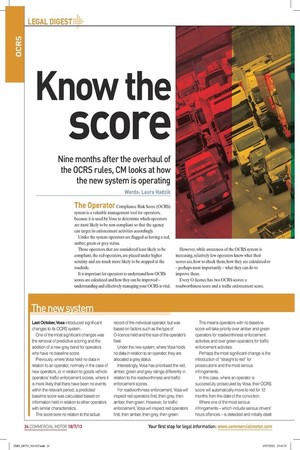Know the score Nine months after the overhaul of the
Page 18

Page 19

If you've noticed an error in this article please click here to report it so we can fix it.
OCRS rules, CM looks at how the new system is operating Words: Laura Hadzik 1 fie Operatof Compliance Risk Score (OCRS) system is a valuable management tool for operators, because it is used by Vosa to determine which operators are most likely to be non-compliant so that the agency can target its enforcement activities accordingly.
Under the system operators are flagged as having a red, amber, green or grey status.
Those operators that are considered least likely to be compliant, the red operators, are placed under higher scrutiny and are much more likely to be stopped at the roadside.
It is important for operators to understand how OCRS scores are calculated and how they can be improved — understanding and effectively managing your OCRS is vital. However, while awareness of the OCRS system is increasing, relatively few operators know what their scores are, how to check them, how they are calculated or — perhaps most importantly — what they can do to improve them.
Every 0-licence has two OCRS scores: a roadworthiness score and a traffic enforcement score. Roadworthiness is based on the condition of the operator's vehicles and is generated by annual tests, fleet inspections and roadside inspections. A traffic enforcement score relates to non-mechanical infringements, such as drivers' hours, tachograph and overloading offences.
The score is based on actual data from events. Points are attributed when a vehicle test, fleet or roadside inspection results in a defect or infringement being identified, a prohibition notice and/or a fixed penalty notice being issued, or a driver or operator being prosecuted.
In the case of a prosecution, points are only allocated when and if a guilty verdict is reached.
The more serious the defect or infringement, the greater the point allocation.
A baseline score is then calculated by dividing the number of points accumulated by the number of events that have taken place over a three-year period, giving an average number of points per event.
There is also a weighting factor for points attributed to an event based on when it occurred. • • For more information, contact Laura Hadzik, senior associate and head of road transport law at JMW Solicitors, on 0161 828 1849, 07831 291 538 or laura.hadzik@jmw.co.uk








































